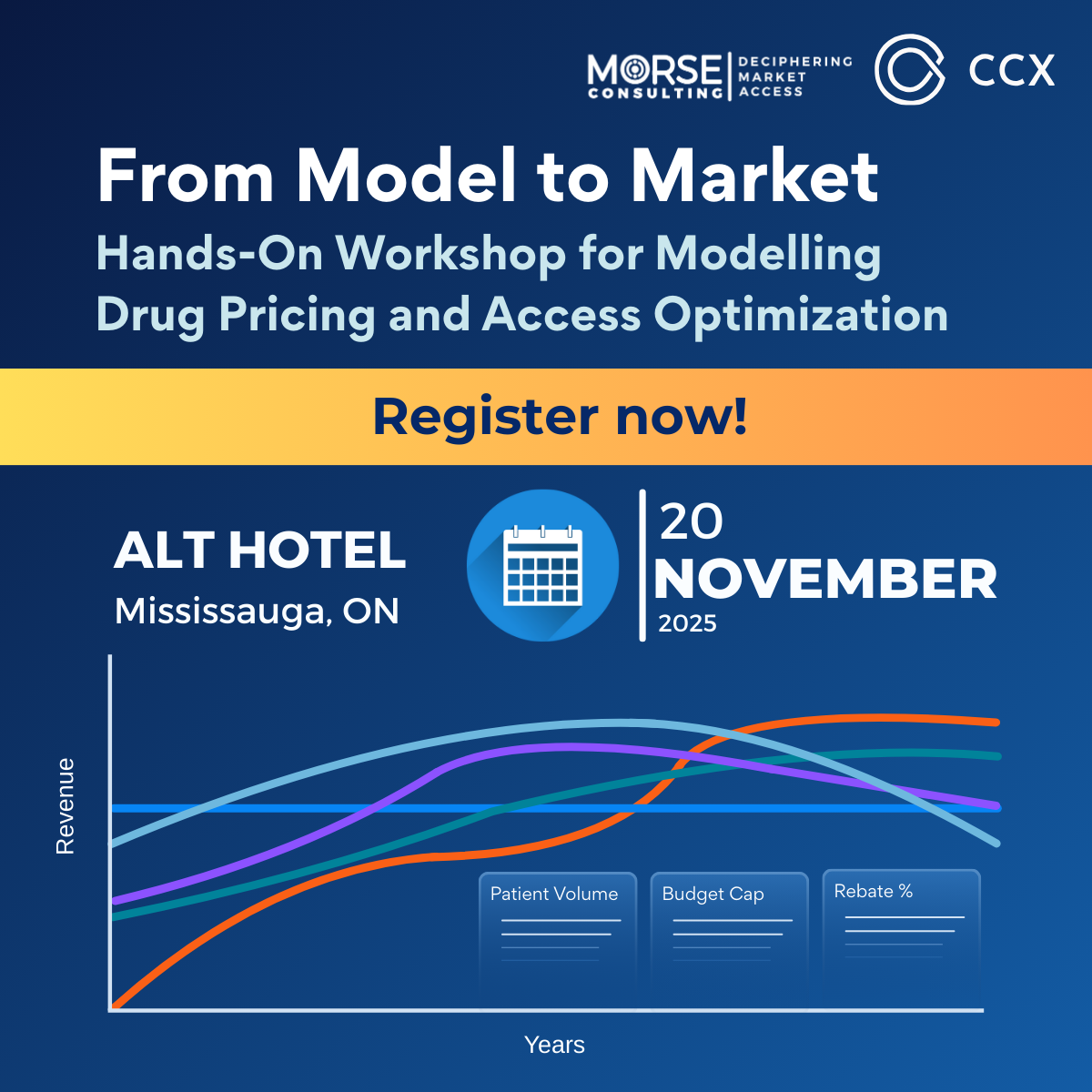MORSE Consulting has prepared a brief summary of the key highlights from the Patented Medicine Prices Review Board’s (PMPRB) recent webinar on the launch of the annual Compass Rx public drug plan expenditure report, 2016/17.
Date: September 12th 2018, 1pm-2pm
Presented by: Elena Lungu, Manager, NPDUIS, Policy and Economic Analysis Branch, PMPRB
Objective: To provide the results of the most recent edition of Compass Rx, an initiative through the National Prescription Drug Utilization Information System (NPDUIS) which analyzes the cost pressures driving changes in prescription drug expenditures in Canadian public drug plans.
Webinar Agenda:
- Trends in prescription drug expenditures, 2012/13-2016/17
- Drug cost drivers 2015/16-2016/17
- Dispensing cost drivers 2015/16-2016/17
- Limitations of the report
- Upcoming initiatives
CompassRx: 4th edition focuses on 2016/17 fiscal year
- Analyzes cost pressures driving change in prescription drug expenditures in Canadian public drug plans, employing an enhanced approach
- Focuses on drugs that received public reimbursement
- Drug costs now include all markups
- Historical results have been updated/improved
- National Prescription Drug Utilization Information System (NPDUIS) is the data source
1) Trends in prescription drug expenditures
- PMPRB reporting looks at entire prescription drug costs (includes what patient pays)
- $8-9B overall yearly prescription drug expenditures historically
- 2015/16 saw a large increase in expenditures (10.8%), pushing it up to $10.5B
- 2016/17 saw an additional 1.9% increase, reaching $10.7B
- Compound annual growth rate of 6.3% in the past 2 years
Public drug plan expenditures: $10.7 billion
- Drug costs (79%, $8.4B) and dispensing costs (21%, $2.2B)
- 86% plan paid and 14% patient paid
- 5.8 million active beneficiaries (1 in 5 people in the identified jurisdictions have been reimbursed/covered by a public plan, equalling 266 million prescriptions reimbursed)
2) Drug cost drivers: largest component, still seeing sizable growth in most provinces
- Net drug cost change mirrors the overall expenditure change
- Large increase in 2015/16 (12% increase), 2016/17 (additional 2% increase)
- Increases in 2016/17 were mainly driven by increased use of higher-cost drugs combined with reduced generic savings and a decline in the use of DAA (direct-acting antiviral) drugs for Hepatitis C
- Variations are mainly due to magnitude of drug-mix and reduction in DAA use
- Curative DAA Hep C drugs increased the 2015/16 costs by 8%, but decreased the drug costs by -2.3% in 2016/17 (due to lower use)
- Net push effects are 7.2% and net pull effects are -5.1% (2016/17 data)
- Demographic and volume effects are consistent drivers of change (usually drives ~2%)
→ New initiative from the pan-Canadian Pharmaceutical Alliance (pCPA):
- Came into effect April 1st, 2018
- Prices of nearly 70 of the most commonly prescribed drugs are reduced by 25-40%
- Impact of generic price reductions from that agreement are not captured in this edition
Drug mix effect: increased use of high-cost drugs (other than DAAs) pushed costs up by 4.4%
- Top contributors: ophthalmological, antineoplastic agents, antithrombotic agents immunosuppressive agents, diabetes drugs, HIV/AIDS antivirals and endocrine therapy
- High cost-drugs are on the rise (used by <2% of beneficiaries, ~28% of total drug costs)
- Number of high cost drugs nearly doubled from 2011/12 (47) to 2016/17 (86)
- 7 of the top 10 highest-cost drugs had average treatment costs >$100,000
- Patented medicine use grew by 5.7%, high cost drugs grew by 17.2% (excludes DAAs)
- Biologics are another growing cost (grew by 7.9%)
→ Major shifts in the therapeutic markup:
- Antineoplastic and immunomodulating agents have replaced cardiovascular system drugs as the top class
- Biologic market shares are on the rise (accounted for 26% of the total drug plan costs 2016/17 ($2.2B, nearly double the amount in 2012/13))
Price change and substitution: decreases costs
- Biosimilar uptake remains modest (total saving offered by biosimilars have been limited)
- Inflectra (-0.04%) and Grastofil (-0.02%)
- Makes only a small (but measurable) difference in overall drug costs
- Market paradox (generics capture a higher share of use while patented medicines capture a higher share of costs)
- Generic price reductions and substitutions resulted in less pronounced cost savings in 2016/17
3) Dispensing cost drivers:
- Growth of dispensing costs in the NPDUIS public plans slowed for the 2nd year in a row
- Overall average dispensing fees decreased by 1.1%
- Mainly due to -2.4% change in Ontario
- Lower dispensing fees results in overall lower costs
- Other provinces have mostly remained constant in dispensing fees
4) Limitations of the report:
- Differences in plan designs and policies among jurisdictions make it difficult to compare
- Expenditures and utilization levels vary
- Demographic and disease profiles vary
- NPDUIS database includes sub-plan data specific to individual jurisdictions
- Further limits comparability of results
- Rebates and confidential product listing agreements are not reflected in the data
- Findings may not be representative of the overall marketplace
- Prescription drug expenditure data for public drug plans represents only one segment of the Canadian pharmaceutical market
5) Upcoming Initiatives:
- Meds Entry Watch 2017
- New section on biosimilars
- Analyzes availability, pricing and sales of new medicines launched in 2016/17
- Market Intelligence Report
- Provides insight into the sales, uptake and prices of anti-VEGFs (another high growth class of biologic drugs)
- Generics 360
- Focuses on the latest trends in Canadian generic drug sales, utilization and pricing within an international context

ISSN: 2369-0518
Cat. no.: H79-6E-PDF
September 2018
PDF – 2.80 MB







